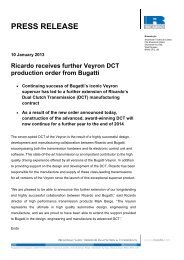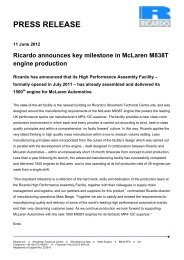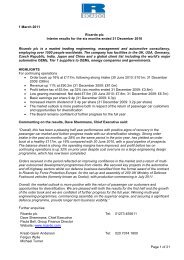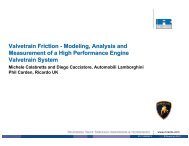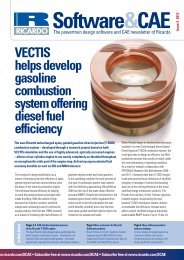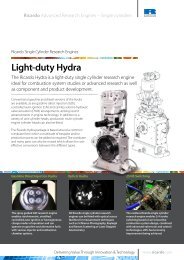The hottest - Ricardo
The hottest - Ricardo
The hottest - Ricardo
You also want an ePaper? Increase the reach of your titles
YUMPU automatically turns print PDFs into web optimized ePapers that Google loves.
Split Carb technology<br />
<strong>The</strong> split carb is simplicity<br />
itself, incurring almost<br />
zero additional<br />
cost<br />
of the<br />
incoming<br />
charge that<br />
passes straight through<br />
the engine and into the exhaust pipe<br />
comprises fresh air rather than<br />
hydrocarbon-laden fuel and air.<br />
Fuel economy is improved, too, and<br />
the concept works so well that airhead<br />
engines are expected to take up<br />
to 90 per cent of the market by 2010,<br />
as Etheridge confirms. “<strong>The</strong>re are<br />
probably a dozen or more air-head<br />
engines in production today and<br />
another 50 under development which<br />
will be introduced over the next few<br />
years. <strong>The</strong>se range from the smallest<br />
grass trimmers of around 25cc to<br />
professional construction equipment<br />
of around 100cc. It is probably true to<br />
say there has never been the degree<br />
of global development in small<br />
engines as there is today.”<br />
Air-head engines incorporate a<br />
second inlet port through which the<br />
fresh air stream is introduced. That in<br />
turn requires a modified fuel system,<br />
and so far some of the favourite<br />
solutions have been double-barrel<br />
butterfly or rotary valve systems, both<br />
of which are complex and costly at<br />
between $10 and $15 per unit for<br />
professional applications. For the<br />
<strong>The</strong> Air-Head Stratified Charge<br />
2-Stroke Engine Cycle<br />
Split Carburettor<br />
Compression and<br />
Induction<br />
Blowdown<br />
Exhaust Period<br />
cheapest hobby products,<br />
the double butterfly units<br />
are around $2 more than a<br />
conventional<br />
carburettor<br />
That is where <strong>Ricardo</strong><br />
comes in. “We didn’t<br />
invent the stratified<br />
charge engine,” quips<br />
Etheridge, “but we<br />
have invented a fuel<br />
system for it.” <strong>Ricardo</strong>’s Split<br />
Carburettor concept is disarmingly<br />
simple, so simple that it does not<br />
require the manufacture of a complete<br />
new carburettor from scratch at all.<br />
Instead, with a minimum of<br />
machining, the Split Carburettor is<br />
created by fitting a plastic ‘floor’ into<br />
the choke of an existing design,<br />
thereby separating it into two<br />
distinctly separate channels. At full<br />
throttle, the existing throttle butterfly<br />
seats tightly onto the end of this<br />
plastic floor, creating one discrete path<br />
for the fuel and air mixture and<br />
another for pure air.<br />
Simple and ingenious<br />
<strong>The</strong> system is as ingenious as it is<br />
simple, requiring no significant<br />
changes to tooling and costing<br />
virtually nothing in manufacturing<br />
terms. Hand-held utility tools fall into<br />
three distinct markets, says Etheridge.<br />
“At the bottom end there’s the hobby<br />
market, the guy who wants to trim his<br />
hedge or cut the grass. <strong>The</strong>se tools<br />
must be as cheap as possible, but they<br />
only need to last around 50 hours.<br />
One major manufacturer makes a<br />
hobby chainsaw and sells 1.5 million<br />
units a year, so a saving of even $0.25<br />
on the manufacturing cost makes a<br />
big difference.”<br />
At the upper end is the professional<br />
market, where a chainsaw may cost<br />
Air<br />
Air + Fuel<br />
Exhaust<br />
Fresh Charge<br />
Transfer<br />
30% of Exhaust<br />
is Air (Low HC<br />
Emissions)<br />
Approaching<br />
Exhaust Closing<br />
over $500. This means the price driver<br />
is not the same because a small<br />
saving has less significance. Yet these<br />
manufacturers are also seeking<br />
operational perfection, so high quality<br />
and long life are essential. <strong>The</strong> third<br />
category is the semi-professional<br />
market, which falls somewhere in<br />
between.<br />
As well as being both a cheap and<br />
reliable solution to the problem of<br />
two-stroke emissions, the Split<br />
Carburettor also has operational<br />
benefits over twin-choke designs. It is<br />
lighter, for a start, but also the throttle<br />
trigger feel is unaffected and remains<br />
smooth and linear throughout the<br />
range. With twin-choke carburettors<br />
there is a definite step as the second<br />
throttle opens, together with a greater<br />
load on the trigger finger, both of<br />
which are important considerations for<br />
an operator who may be working with<br />
the equipment for hours on end.<br />
Demonstrating to customers<br />
It is one thing to design a<br />
revolutionary new low-cost system,<br />
but it is quite a different matter to<br />
convince prospective customers that it<br />
works. In this case, <strong>Ricardo</strong> was able<br />
to provide compelling live<br />
demonstrations proving that the Split<br />
Carburettor was a match for the<br />
double-barrel design in real time. It<br />
also demonstrated superior<br />
performance with stronger torque<br />
characteristics at low speed, more<br />
effective transient response and<br />
smaller size for better packaging. In<br />
terms of cost, <strong>Ricardo</strong> believes its<br />
carburettor to be as much as $1.50<br />
cheaper per unit than the doublebarrel<br />
butterfly solution with its extra<br />
throttle plate and complex linkages.<br />
<strong>The</strong> first product using the Split<br />
Carburettor design, a concrete cutter,<br />
will be on the market soon, and many<br />
other hand-held products will follow.<br />
Still on the agricultural and gardening<br />
scene, <strong>Ricardo</strong> expects air-head twostrokes<br />
equipped with Split<br />
Carburettors to find their way into<br />
non-hand held low cost products such<br />
as pressure washers, pumps and lawn<br />
mowers, competing in a market that<br />
has so far been dominated entirely by<br />
the four-stroke engine.<br />
Beyond that, there are further<br />
opportunities too, such as the Asian<br />
commuter motorcycle and scooter<br />
market. Split Carburettor technology is<br />
ideally suited to the small two-stroke<br />
motorcycles and motorised rickshaws<br />
which are creating major air quality<br />
problems in Asian cities. <strong>Ricardo</strong> has<br />
16 RICARDO QUARTERLY REVIEW • Q3, 2006





